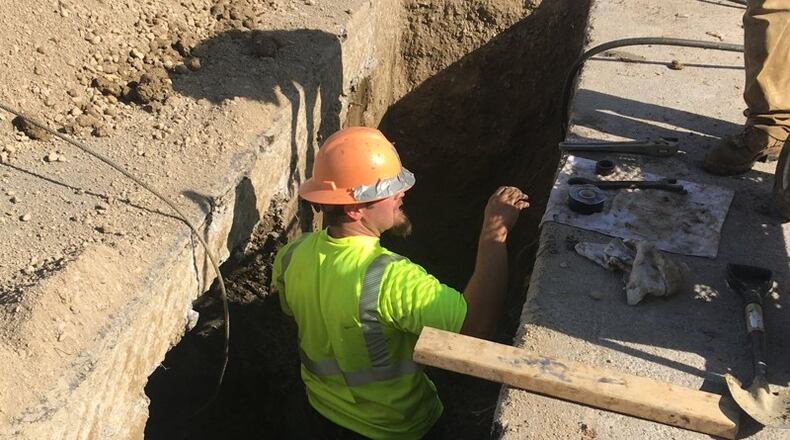“No more patchwork repairs, no more half fixes, no more kicking the can down the road,” Donatvius Jarrells, D-Columbus, said during a recent press conference. “We’re going to get this right for families and children.”
Prolonged lead exposure can cause a variety of health problems, and a recent study showed the percentage of Ohio children with elevated levels of lead was nearly double the national average.
Jarrells and Monica Robb Blasdel, R-Columbiana, are the primary sponsors of House Bill 307.
A hard 15-year deadline
HB 307 would require all lead service lines in Ohio — both public and private — to be replaced within 15 years of the bill’s effective date. The bill would also require the Ohio Environmental Protection Agency’s director to establish, enforce and track the “Lead Service Line Replacement Program.”
The owners of public water systems would be tasked with identifying and overseeing the removal of all lead service lines within their systems.
The legislation would include key provisions that support workforce development and ensure low- and moderate-income customers will not be burdened by the cost of replacement.
Water filters and education about lead exposure would also be provided to households “before, during and after” service line replacements.
Jarrells attempted to pass a similar bill last year, but it stalled in the Energy and Natural Resources committee after its first hearing and lacked bipartisan support.
This version aims to put a firm deadline on the federal push to replace lead service lines, Blasdel said.
The Biden Administration updated federal regulations for lead and copper. The final rule, greenlit last fall, will require cities to replace their lead service lines in 10 years. This mandate is set to take effect in November 2027.
But cities can request extensions during this process. The two lawmakers fear this could cause some communities to not see lead water lines removed for decades.
“There are pockets of this state that have water quality as bad as Flint, Michigan,” said Jarrells. “That’s unacceptable.”
Funding, support
The bill, in its early stages, was referred to the Development Committee of the Ohio House, and received praise from environmental and health advocacy groups.
“The Lead Line Replacement Act is a common-sense solution that protects public health, creates jobs, and secures a safer future for every Ohio family. This legislation finally puts Ohio’s most vulnerable first and empowers water systems across the state,” said Annalisa Rocca of the Ohio Environmental Council Action Fund.
Lead remediation has its advantages. A 2024 study by the Ohio Environmental Council estimated that every dollar invested in the complete removal of lead pipes would return anywhere from $32 to $45 in public health and economic benefits. That study also estimates that a successful program would enhance Ohio’s economy between $145 billion and $185 billion over the next 15 years.
Credit: AP
Credit: AP
State Reps. Andrea White, R-Kettering, and Tom Young, R-Centerville, both said efforts to remediate lead from housing and to prevent lead poisoning are important endeavors. But both said they need to learn more about how those efforts will be funded before signing on in support of HB 307.
“I look forward to watching this legislation progress,” White said. “We need to continue to take lead poisoning prevention seriously.”
Revitalizing or rebuilding existing housing stock in Ohio’s cities could help alleviate the housing shortage experienced across the state, Young said. But the burden of lead remediation for city housing is often on young homebuyers or others who are entering the housing market for the first time.
“It’s costly. It’s a real issue, and that’s something that needs to be brought to the forefront,” he said.
Young said he’s also curious about what workforce is available to carry out this endeavor.
“Do we have the expertise to be able to do quality inspections and remediation?” he said. “Are there new technologies that could help us with the remediation of this? That’s really something I’d be interested in knowing.”
Mapping lead in Dayton
Since 2016, Ohio has required owners of public water systems to “identify areas that are known to contain or likely to contain lead service lines” and report that information to the state.
The Ohio EPA maintains a database of maps submitted to the state by public water systems. Dayton’s most recent maps were submitted in 2022 and show the public and private portions of lead service lines, confirmed non-lead service lines and service lines with unknown lead statuses.
A Dayton Daily News analysis of these maps in 2024 found that Dayton neighborhoods like Wright View had a mix of all three lead statuses. Other neighborhoods like Belmont, Burkhardt, Cornell Heights, Eastern Hills and the Dayton View Triangle neighborhood that runs along Salem Avenue have hundreds of properties where it’s unknown if the pipes contain lead.
And Dayton’s public water system serves hundreds of thousands of residents in Montgomery and Greene Counties, too. According to the city’s 2023 water quality report, samples collected in the water distribution system show that 90% of the samples tested contained less than 3 parts per billion of lead.
“Every community is not absolved of this issue,” Jarrells said. “But every community is at a different place when it comes to abating these lead service lines.”
Credit: Alexis Larsen
Credit: Alexis Larsen
Lasting health impacts
Research shows that prolonged lead exposure can cause developmental harm to infants and young children and numerous other health concerns.
There is no safe level of exposure to lead, but blood is considered “elevated” when it contains more than 5 micrograms per deciliter.
A 2021 study by JAMA Pediatrics found that 5.2% of Ohio’s children had elevated levels of lead in their system — this is nearly twice the national average.
For Jarrells, this statistic hits close to home: he suffered from the effects of lead poisoning as a child growing up in Cleveland.
“This is silently killing our children,” he said.
But state officials say the most common culprit in lead poisoning for children is lead-based paint. Children are most commonly exposed to lead by dust from paint, lead-contaminated soil or playing with toys that have lead-based paint on them.
But adults and children can also be exposed to lead by contaminated drinking water. This is especially impactful to pregnant people and infants who drink formula, health experts say.
Avery Kreemer contributed to this report.
About the Author




